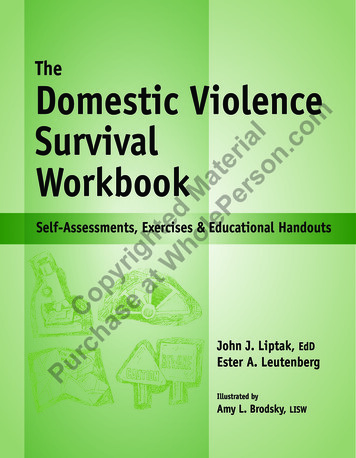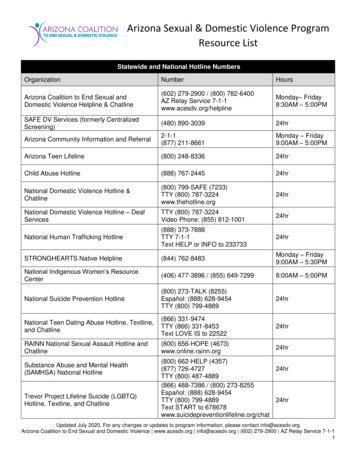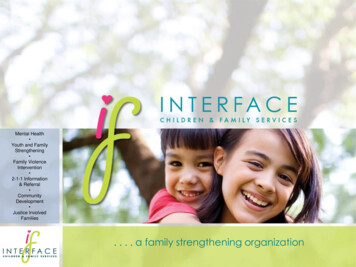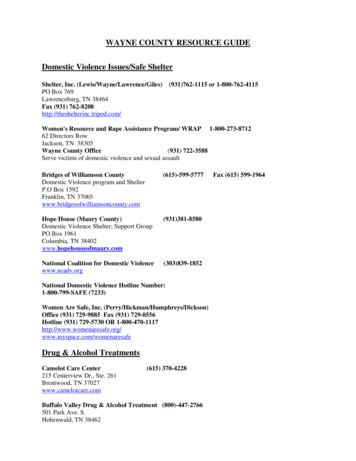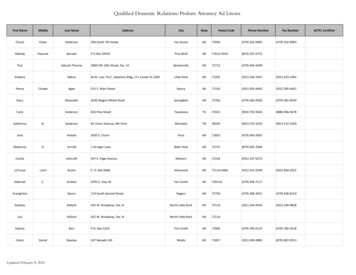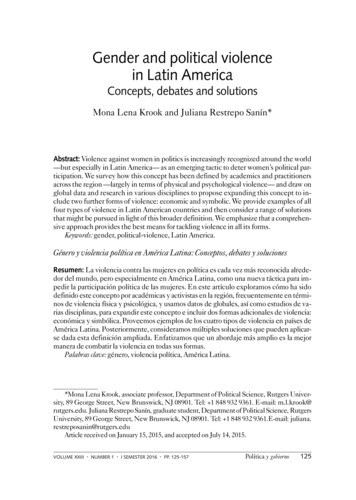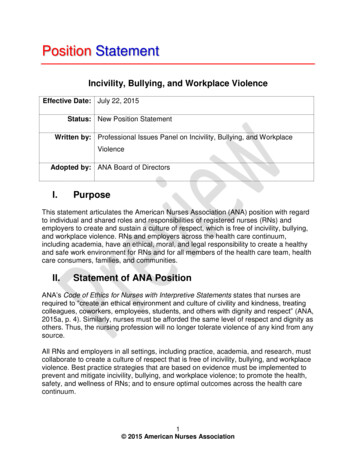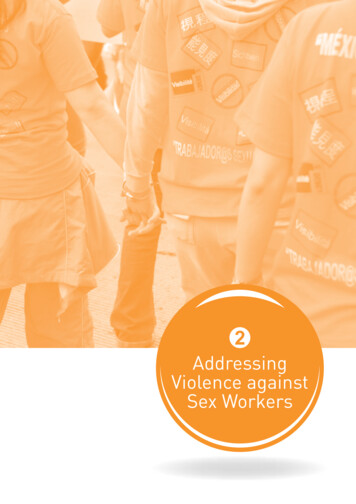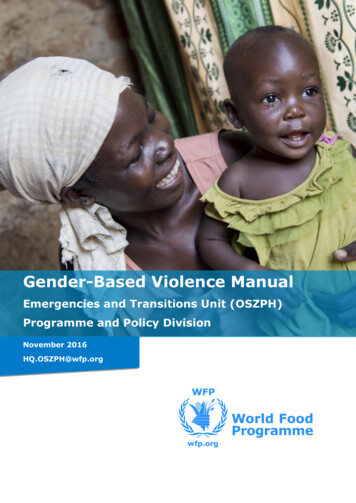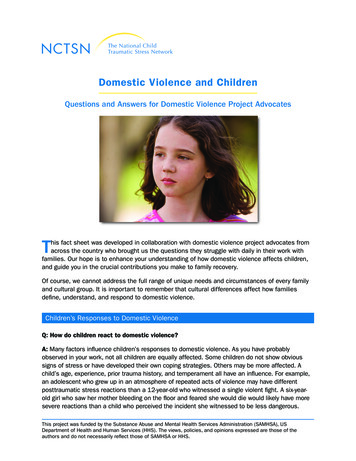
Transcription
Domestic Violence and ChildrenQuestions and Answers for Domestic Violence Project AdvocatesThis fact sheet was developed in collaboration with domestic violence project advocates fromacross the country who brought us the questions they struggle with daily in their work withfamilies. Our hope is to enhance your understanding of how domestic violence affects children,and guide you in the crucial contributions you make to family recovery.Of course, we cannot address the full range of unique needs and circumstances of every familyand cultural group. It is important to remember that cultural differences affect how familiesdefine, understand, and respond to domestic violence.Children’s Responses to Domestic ViolenceQ: How do children react to domestic violence?A: Many factors influence children’s responses to domestic violence. As you have probablyobserved in your work, not all children are equally affected. Some children do not show obvioussigns of stress or have developed their own coping strategies. Others may be more affected. Achild’s age, experience, prior trauma history, and temperament all have an influence. For example,an adolescent who grew up in an atmosphere of repeated acts of violence may have differentposttraumatic stress reactions than a 12-year-old who witnessed a single violent fight. A six-yearold girl who saw her mother bleeding on the floor and feared she would die would likely have moresevere reactions than a child who perceived the incident she witnessed to be less dangerous.This project was funded by the Substance Abuse and Mental Health Services Administration (SAMHSA), USDepartment of Health and Human Services (HHS). The views, policies, and opinions expressed are those of theauthors and do not necessarily reflect those of SAMHSA or HHS.
A child’s proximity to the violence also makes a difference. Consider the very differentexperiences of a 12-year-old child who was in another room with headphones on while herparents battled; an eight-year-old who had to call 911 despite a raging parent’s threats againsthim; and a teenager who has frequently put himself at risk by getting into the middle of fights toprotect his mother from her estranged boyfriend.Here are some of the factors that can influence children’s reactions to domestic violence: The severity of the violence (Was it life-threatening? Did the victim express terror in frontof the child? Was a weapon used or brandished? Was there a serious injury?) The child’s perception of the violence (A child may perceive violence as life-threateningeven if adults do not.) The age of the child (see table, Possible Reactions to Domestic Violence, page 4) The quality of the child’s relationships with both parents (or involved parties) The child’s trauma history (What other traumatic events has the child experienced? Wasthe child also a victim of physical abuse?) Secondary adversities in the child’s life, such as moving, changing schools, or leavingbehind support systems 1,2Q: What are some typical short-term responses?A: Children commonly respond to domesticviolence as they do to other traumatic events.Short-term traumatic stress reactions include2 Hyperarousal. The child may becomejumpy, nervous, or easily startled. Reexperiencing. The child may continueto see or relive images, sensations, ormemories of the domestic violence despitetrying to put them out of mind. Avoidance. The child may avoid situations,people, and reminders associated withthe violence, or may try not to think or talkabout it. Withdrawal. The child may feel numb,frozen, or shut down, or may feel and actas if cut off from normal life and otherpeople.Domestic Violence and Children: Questions and Answers for Domestic Violence Project AdvocatesNovember 2010
Reactions to reminders. The child may react to anyreminder of the domestic violence. Sights, smells,tastes, sounds, words, things, places, emotions,even other people can become linked in the child’smind with the traumatic events. For example, aschool-age child may become upset when watchinga football game because the violent contactbetween players is a reminder of domestic violence.Sometimes behavior that seems to come out ofnowhere, such as a sudden tantrum, is actually areaction to a trauma reminder.Ariel, an 11-monthold who was presentwhen her motherwas attacked byher boyfriend, keptwaking up at nightscreaming. Trouble going to sleep or staying asleep, or having nightmares. Repetitive talk or play about the domestic violence. For example, a young girl may act outviolence when playing with her dolls.Other short-term symptoms may include anxiety (for example, separation anxiety); depression;aggression (perhaps reenactment of the witnessed aggression); physical complaints(stomachaches, headaches); behavioral problems (fighting, oppositional behavior, tantrums);feelings of guilt or self-blame; and poor academic performance.Q: What about children’s responses in the long term?A: Research suggests that in the long term, children whohave been exposed to domestic violence—especially thosechildren who do not receive therapeutic intervention—may be atincreased risk ofTen-year-old Paul,who frequentlywitnessed violentfights between hisparents, punchedanother boy whoteased him in lineat school. Depression and anxiety Substance abuse Self-destructive or suicidal behaviors Impulsive acts, including risky sex and unintendedpregnancy Chronic health problems Low self-esteem Criminal and violent behavior (including perpetration of domestic violence) Victimization by an intimate partnerThe National Child Traumatic Stress Networkwww.NCTSN.org3
Possible Reactions to Domestic ViolenceBirth to age 5Ages 6–11Ages 12–18Sleep or eating disruptionsNightmares, sleep disruptionsAntisocial behaviorWithdrawal or lack ofresponsivenessAggression and difficulty withpeer relationships in schoolSchool failureIntense and pronounced separationanxietyDifficulty with concentrationand task completion in schoolCrying inconsolablyWithdrawal and emotionalnumbing Substance abuseSchool avoidance or truancy Involvement in violentor abusive datingrelationshipsDevelopmental regression, lossof acquired skills such as toilettraining, or reversion to earlierbehaviors, such as asking for abottle againStomachaches, headaches, orother physical complaintsIntense anxiety, worries, or new fearsIncreased aggression or impulsivebehaviorActing out witnessed events in play,such as having one doll hit anotherdollImpulsive or reckless behavior,such as Truancy Running awayDepressionAnxietyWithdrawalSelf-destructive behavior suchas cuttingIt is important to remember that any of these symptoms can also be associated with other stress, traumas, or developmentaldisturbances. They should be considered in the context of the child’s and family’s functioning.Q: What are the factors that help children recover?A: Most children are resilient if giventhe proper help following traumaticevents. Research has shown that thesupport of family and community arekey to increasing children’s capacityfor resilience and in helping them torecover and thrive.1Crucial to a child’s resiliency is thepresence of a positive, caring, andprotective adult in a child’s life. Althougha long-term relationship with a caregiveris best, even a brief relationship withone caring adult—a mentor, teacher,day-care provider, an advocate in adomestic violence shelter—can makean important difference.4Domestic Violence and Children: Questions and Answers for Domestic Violence Project AdvocatesNovember 2010
Here are some other protective factors for children: Access to positive social supports (religious organizations, clubs, sports, group activities,teachers, coaches, mentors, day care providers, and others) Average to above average intellectual development with good attention and social skills Competence at doing something that attracts the praise and admiration of adults and peers Feelings of self-esteem and self-efficacy Religious affiliations, or spiritual beliefs that give meaning to lifeFrom Parent to Child: Support and Communication about Domestic ViolenceQ: What should parents tell their children about domestic violence?A: Some parents may be reluctant to tell you that their children have witnessed domestic violence.Others may try to minimize the children’s actual exposure to the violence (saying, for example,“They didn’t know it was happening,” or “They were always asleep or at school”).A victimized parent may also avoid talking to a child aboutdomestic violence. The parent may assume that a childis too young to understand, or that it’s better to justmove on. But many children who’ve experienced domesticviolence need to talk about it. They may misunderstandwhat happened or why it happened. They may blamethemselves, blame the victim, or blame the police orother authorities who intervened. They may have fantasiesabout how they can “fix” their family. They may takeparental silence as a signal to keep silent themselves orto feel ashamed about what happened in their family.When his aunt told Charlie,“You know, you can ask meanything you need to aboutwhat happened yesterday,”the preschooler broke hissilence for the first timesince his dad was takenaway.As a domestic violence advocate, you may be in the position of speaking to children yourself. Ifnot, you can support the parents in breaking the silence. Start by assuming that children knowmore than we think they know. Talk to them about what happened, listen openly to what theyhave to say, and offer the following key messages: “The violence was not and is not okay.” “It is not your fault.” “I will listen to you.” “You can tell me how you feel; it is important.” “I’m sorry you had to see (or hear) that.”The National Child Traumatic Stress Networkwww.NCTSN.org5
“You do not deserve to have this in your family.” “It is not your job or responsibility to prevent or change the situation.” “We can talk about what to do to keep you safe if it happens again” (such as staying inthe bedroom, going to neighbors, calling a relative or 911). “I care about you. You are important.”3 “It is the job of adults to keep kids safe. There are adults who will work to keep you andyour family safe.”Q: How much information is enough but not too much?A: Parents often struggle with how much specific information to share with children about whathappened during a domestic violence incident. To gauge the right level of discussion, parents willfind it helpful to Think about how to present the information in a form the child will understand. The amountof detail shared will often depend on the age and developmental stage of the child. Start by providing straightforward messages of support (see above), or by asking what thechild saw, feels, or thinks about what happened. Ask the child if he or she has questions. Children will often stop asking questions whenthey have enough information to feel safe and secure. Refrain from giving them moreinformation than they need or want. Remember that it is always okay to ask children what they know and what they think. Understand that giving children an opportunity to talk openly and ask questions aboutwhat they experienced can be more effective than reviewing the details from the adult’sperspective.Q: What should a parent tell a child about the parent who was abusive?A: Parents who have experienced domestic violence often seek guidance on what to tell theirchildren about the parent or partner who was abusive. Here are some key messages for children:6 The abusive behavior was not okay; violence is not okay. The abusive person is responsible: “It’s not your fault. It’s not my fault.” It’s okay to love and want to spend time with the person who was abusive. It’s okay to be mad at or scared of the person who was abusive. It’s also okay to feel mad at but still love the person who was abusive.3Domestic Violence and Children: Questions and Answers for Domestic Violence Project AdvocatesNovember 2010
Protecting Children and Coping with their Feelings and BehaviorsQ: How can advocates protect children from adult information?A: As an advocate, you may findyourself filling out legal paperwork,discussing details, and reviewingdomestic violence incidents with clientsin the presence of their children.Hearing the specific details of eventscan act as a trauma reminder forchildren. The descriptions themselvescan be disturbing, as can the parent’sdistress in recounting them. A child tooyoung to understand the content canstill become upset. Even babies reactto a caretaker’s emotional distress withtheir own increased heart rates andsigns of stress. The situation presentsa challenge for advocates, but thefollowing strategies can guide you inprotecting children: If at all possible, avoid talkingabout the specifics of thedomestic violence in front ofchildren. Maintain a child-friendly waitingarea for children old enough towait on their own. Offer toys and games that maydistract or comfort children ifthey have to be in the room with adults. Inform children that the advocate and parent are going to be talking about whathappened, and that they might have some feelings about this. Check in on the child’sfeelings throughout the conversation, and offer comfort and reassurance. Encourage parents whenever possible to use natural supports for child care (such asfriends, families, or familiar service providers), or ask if there is someone who can comeand stay in the waiting room with the children for at least part of the time. Seek volunteers to provide child care during regularly scheduled hours in outreach officesand shelters.The National Child Traumatic Stress Networkwww.NCTSN.org7
Q: How should parents respond to and cope with their children’s feelings about them?A: Children who have witnessed domestic violence often have confused and contradictoryfeelings. They may worry about the safety of the parent who has been abused. They may alsoworry that their parents won’t be able to protect them. They may see the parent who wasabusive as generous and loving some of the time, and terrifying and dangerous at other times.They may even blame the abused parent for causing the abuse that led to separation from theother parent. Often, children feel torn over loyalties and caught in the middle. Here are somemessages to offer children to help them explore and cope with these feelings:Carly tried to“fix” her family byrushing home fromschool each dayto cook and cleanfor her abusedmother. It is okay to feel more than one emotion at the same time(such as anger and love). It is normal to feel angry at either or both parents whenviolence happens. You can love someone and hate that person’s behavior. It’s okay to love both parents at the same time. Violence is an adult problem and it is not your fault orresponsibility. You can’t fix it.3Q: What are some strategies for managing children’s behaviors that may occur in families withdomestic violence?A: A parent who has experienced domestic violence may expend a lot of energy simply survivingand helping the children survive. Other aspects of parenting may suffer as a consequence. Theparent may become either overly permissive or too rigid and harsh in applying discipline. Or theparent may be inconsistent and fluctuate between permissiveness and harshness. Roles in thefamily may have become reversed. Children may have taken on parenting responsibilities in aneffort to care for and protect family members.In addition to providing emotional support and safety for families following domestic violence,advocates may need to model better parenting and offer strategies for behavior management.Indeed, these strategies may be needed immediately for some families in offices and shelters.Basic strategies include 8Active ignoring or “picking your battles.”Children’s negative behaviors may beefforts to get attention from adults.An effective strategy is to identify thebehaviors that can be ignored. Of course, aparent cannot ignore unsafe behaviors, butwithdrawing attention from other negativeor unwanted behaviors should eventuallydecrease them.Domestic Violence and Children: Questions and Answers for Domestic Violence Project AdvocatesNovember 2010
Specific praise. Using very specific praise to reward positive behavior not only increasesthe likelihood that the behavior will be repeated, but helps children feel valued and proudof themselves. Active ignoring is often most effective when paired with specific praise. Rules and routines. Structured, consistent, and predictable rules and routines canbe extremely helpful. Children living with domestic violence often see the world asunpredictable and unsafe. Maintaining consistent rules and routines teaches children thatlife can be predictable. It also helps improve behavior problems and contributes to thechild’s sense of safety. Relaxation. Teaching children simple relaxation skills, such as deep breathing, andproviding the space for them to practice relaxing, can be very effective in helping themmanage fear and anxiety. Relaxation can decrease acting-out behavior that may be dueto anxiety and exposure to trauma reminders. For younger children, providing a safe andquiet place to play and explore can be helpful. Adequate support. Parents who get help and support in coping with their own feelingsare better equipped to help their children. They should be encouraged to seek help frommental health professionals or other support systems.Q: How can advocates determine when a child needs more help?A: Exposure to domestic violence can place children at risk for a variety of emotional, social,and behavioral problems. Some children, including those who exhibit the following warning signs,may require additional professional help to achieve recovery. If parents describe these signs, youshould consider talking with them about seeking additional help: The child’s traumatic stress reactions—such as reexperiencing, withdrawal, arousal,sleep disturbances, and reactions to trauma reminders—are severe enough to interferewith daily life. The child doesn’t seem like herself. The child’s behavior ormood has changed. The child is having significant trouble eating or sleeping,or complains of a lot of physical symptoms that have noapparent medical cause. The child’s behaviors are becoming more risky and lesspredictable. The child seems sad, depressed, clingy, hopeless, orwithdrawn from activities that were once loved. The child talks about dying or engages in self-injurious behaviors such as substanceabuse, unhealthy sexual activity, cutting, or head banging. The child is increasingly worried, anxious, or fearful, or exhibits increased anger or aggression.The National Child Traumatic Stress Networkwww.NCTSN.orgAndrew, an 11thgrader, withdrewfrom his friendsand stopped tryingin school after thepolice failed toput his mother’sabusive boyfriendin jail.9
Maintaining Personal Health and Well-BeingQ: What is secondary trauma and how does it affect me?A: Caring for survivors of domestic violence and their children can exact a toll. In the process ofhearing the vivid details of domestic violence, and responding with empathy, advocates themselvescan experience traumatic stress reactions. A victim’s story may even serve as a trauma reminder ifyou have experienced domestic violence or other traumatic events in your own life.After Barbara heardthe vivid details ofher client’s abuse,she found herselfdreading the client’snext appointment.Repeated exposure to trauma reminders can compromise yourhealth and well-being. For example, you may feel overwhelmedby what you have heard or seen, and perhaps find yourselflosing patience with a demanding mother or child. Reactionslike these are often referred to as signs of secondary traumaticstress (or compassion fatigue, or vicarious trauma). Secondarytrauma is not a sign of weakness or lack of skill. It is a normalresponse to working in the field of domestic violence advocacy.Possible signs of secondary traumatic stress include Increased irritability or impatience with clients Intense feelings and intrusive thoughts (including nightmares) about a client’s trauma Changes in how you experience yourself, others, and the world Persistent anger or sadness Increased fatigue or illness Disconnection from your colleagues or loved onesIf you notice these or other signs of secondary trauma, take steps to care for yourself and getsupport relevant to your work. Consider these possible strategies:10 Talk to a professional if your symptoms are affecting your day-to-day functioning at workor at home. Seek professional help to address your own history of domestic violence or other trauma. Reach out to team leaders, managers, and colleagues for support. Renew your commitment to creating a work-life balance. Identify and use coping strategies to manage stress. Utilize personal support systems. Attend to your physical, spiritual, and emotional health needs. Take some time off.Domestic Violence and Children: Questions and Answers for Domestic Violence Project AdvocatesNovember 2010
For further information about the impact of domestic violenceon children and families, these Web sites offer valuableresources for advocates and parents: National Child Traumatic Stress Networkhttp://www.nctsn.org National Center for Children Exposed to Violencehttp://www.nccev.org Safe Start Centerhttp://www.safestartcenter.org National Coalition Against Domestic Violencehttp://www.ncadv.org Office on Violence Against Womenhttp://www.enditnow.govReferences1. Edleson, J. L., in consultation with Nissley, B. (2006). Emerging responses to childrenexposed to domestic violence. Harrisburg, PA: VANet, of the National Resource Center onDomestic Violence/Pennsylvania Coalition Against Domestic Violence. Retrieved July 29,2008, from: http://www.vawnet.org2. National Child Traumatic Stress Network (2008). Questions and answers about domesticviolence: An interview with Betsy McAlister Groves, MSW. Available at: http://www.nctsn.org3. Crager, M., and Anderson, A. (1997). Helping children who witness domestic violence: A guidefor parents. Minnesota Center Against Violence and Abuse. Retrieved December 16, 2009,from: tructor.htmlAcknowledgmentsThe content of this fact sheet was developed and adapted by Rebecca Brown, LCSW, FayeLuppi, JD, and other members of The Greater Portland Children’s Trauma Response Initiativeof Community Counseling Center in Portland, ME, in collaboration with the Domestic ViolenceCollaborative Group of the National Child Traumatic Stress Network (NCTSN).The National Child Traumatic Stress Networkwww.NCTSN.org11
Recommended CitationNational Child Traumatic Stress Network, Domestic Violence Collaborative Group. (2010). Domestic violence andchildren: Questions and answers for domestic violence project advocates. Los Angeles, CA, and Durham, NC: NationalCenter for Child Traumatic Stress.Copyright 2010, National Center for Child Traumatic Stress on behalf of Rebecca Brown, LCSW, Faye Luppi, JD,and the National Child Traumatic Stress Network. This work was funded by the Substance Abuse and Mental HealthServices Administration (SAMHSA), US Department of Health and Human Services (HHS), which retains for itself andothers acting on its behalf a nonexclusive, irrevocable worldwide license to reproduce, prepare derivative works, anddistribute this work by or on behalf of the Government. All other rights are reserved by the copyright holder(s).About the National Child Traumatic Stress NetworkEstablished by Congress in 2000, the National Child Traumatic Stress Network (NCTSN) is a unique collaborationof academic and community-based service centers whose mission is to raise the standard of care and increaseaccess to services for traumatized children and their families across the United States. Combining knowledge of childdevelopment, expertise in the full range of child traumatic experiences, and attention to cultural perspectives, theNCTSN serves as a national resource for developing and disseminating evidence-based interventions, trauma-informedservices, and public and professional education.12Domestic Violence and Children: Questions and Answers for Domestic Violence Project AdvocatesNovember 2010
6 Domestic Violence and Children: Questions and Answers for Domestic Violence Project Advocates November 2010 “You do not deserve to have this in your family.” “It is not your job or responsibility to prevent or change the situation.” “We can talk about what to do
